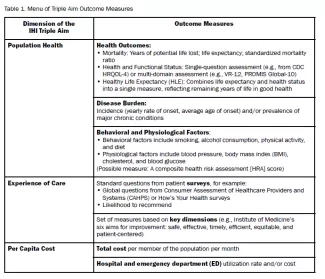Why It Matters
The principles that apply to good measurement, in general, apply to measurement of the Triple Aim. What key measurement principles apply to the Triple Aim?
- The need for a defined population
The frame for the Triple Aim is a population, and the measures, especially for population health and per capita cost, require a population denominator. The total population refers to all the residents of a geopolitical area, within which a variety of sub-populations can be defined. Sub-populations can be defined in a variety of ways, including by income, race/ethnicity, disease burden, or those served by a particular health system or in a particular workforce. Populations served by a Triple Aim initiative might be either a total population or a sub-population defined in this way; in either case, it is essential to specify the population. - The need for data over time
In improvement science, tracking data over time helps to distinguish between common cause and special cause variation, to gain insight into the relationship between interventions and effects, and to better understand time lags between cause and effect. - The need to distinguish between outcome and process measures, and between population and project measures
Measurement for the Triple Aim can be constructed hierarchically, with top-level population outcome measures for each dimension of the Triple Aim, and with related outcome and process measures for projects that support each dimension. - The value of benchmark or comparison data
While data tracked and plotted over time help to measure improvement, benchmark or comparison data enable comparisons with other systems. Benchmarking is easier if the measures selected are standardized and in the public domain.
Based on these measurement principles, the following menu of Triple Aim outcome measures evolved within the IHI Triple Aim prototyping initiative (see Table 1).

The menu is intended to provide guidance to organizations seeking to measure the Triple Aim. Selection of measures will depend in part on data availability, resource constraints, and overall objectives.
Kevin Nolan, MStat, MA, Statistician and Consultant, Associates in Process Improvement, is also a Senior Fellow at the Institute for Healthcare Improvement. Matthew C. Stiefel, MPA, MS, is Senior Director, Center for Population Health, Care Management Institute at Kaiser Permanente.
Editor’s Note: The IHI white paper A Guide to Measuring the Triple Aim provides other useful considerations for development of measures applicable to the Triple Aim in Appendix A. It also offers detailed descriptions of potential Triple Aim outcome measures, including data sources and examples, in Appendix B.
